 White-Bellied Sea Eagle is an Indian bird with a scientific name "Haliaeetus leucogaster", also known as the white-breasted sea eagle, is a large diurnal bird of prey in the family Accipitridae.
White-Bellied Sea Eagle is an Indian bird with a scientific name "Haliaeetus leucogaster", also known as the white-breasted sea eagle, is a large diurnal bird of prey in the family Accipitridae.
Coining of White-Bellied Sea Eagle
White-Bellied Sea Eagle is originally described by Johann Friedrich Gmelin in the year 1788. This bird is closely related to Sanford`s sea eagle of the Solomon Islands, and the two are considered a super species.
Structure of White-Bellied Sea Eagle
White-Bellied Sea Eagle is a distinctive bird. The adult White-Bellied Sea Eagle has a white head, breast, under-wing coverts and tail. The upper parts are grey and the black under-wing flight feathers contrast with the white coverts. The tail is short and wedge-shaped as in all Haliaeetus species. Like many raptors, the female is slightly larger than the male, and can measure up to 90 cm (35 in) long with a wingspan of up to 2.2 m (7.2 ft), and weigh 4.5 kg (9.9 lb). Immature birds have brown plumage, which is gradually replaced by white until the age of five or six years. The call is a loud goose-like honking.
Concentration of White-Bellied Sea Eagle
White-Bellied Sea Eagle is the close resident from India and Sri Lanka through Southeast Asia to Australia on coasts and major waterways, the white-bellied sea eagle breeds and hunts near water, and fish form around half of its diet. Opportunistic, it consumes carrion and a wide variety of animals. Although rated of Least Concern globally, it has declined in parts of Southeast Asia such as Thailand, and south-eastern Australia. It is ranked as Threatened in Victoria and Vulnerable in South Australia and Tasmania. Human disturbance to its habitat is the main threat, both from direct human activity near nests which impacts on breeding success, and from removal of suitable trees for nesting. The white-bellied sea eagle is revered by indigenous people in many parts of Australia, and is the subject of various folk tales throughout its range.
 Body of White-Bellied Sea Eagle
Body of White-Bellied Sea Eagle
White-Bellied Sea Eagle has a white head, rump and under parts, and dark or slate-grey back and wings. In flight, the black flight feathers on the wings are easily seen when the bird is viewed from below. The large, hooked bill of White-bellied sea eagle is a leaden blue-grey with a darker tip, and the irides are dark brown. The cere of White-bellied sea eagle is also lead grey. The legs and feet of White-bellied sea eagle are yellow or grey, with long black talons (claws). The wings of White-bellied sea eagle are modified when gliding so that they rise from the body at an angle, but are closer to horizontal further along the wingspan. In silhouette, the comparatively long neck, head and beak stick out from the front almost as far as the tail does behind. For active flight, the white-bellied sea eagle alternates strong deep wing-beats with short periods of gliding.
Feedings of White-Bellied Sea Eagle
White-bellied sea eagles feed alone, in pairs, or in family groups. A pair may cooperate to hunt. The prey of White-bellied sea eagle can be eaten while the bird is flying or when it lands on a raised platform such as its nest. White-bellied sea eagle skins the victim as it eats it. White-bellied sea eagle is exceptionally efficient at digesting its food, and disgorges only tiny pellets of fragmented bone, fur and feathers.











